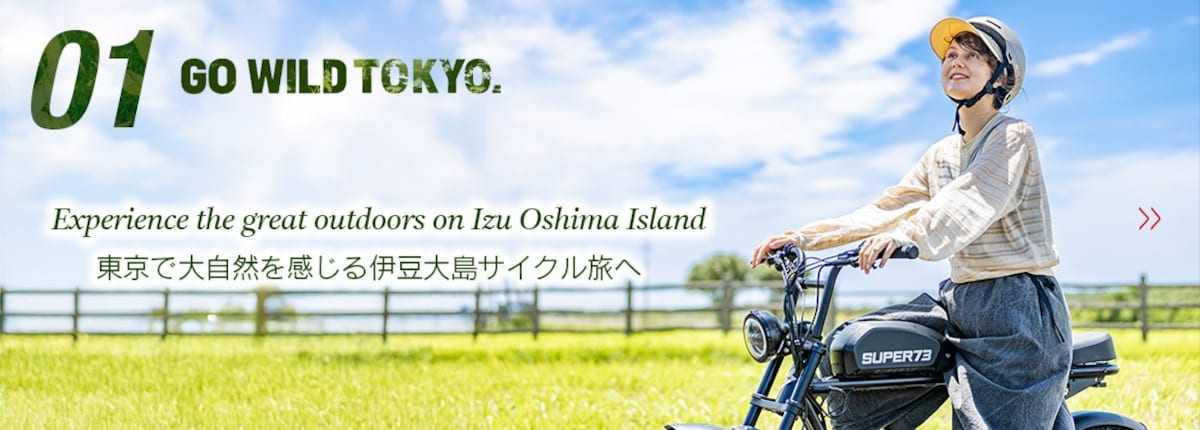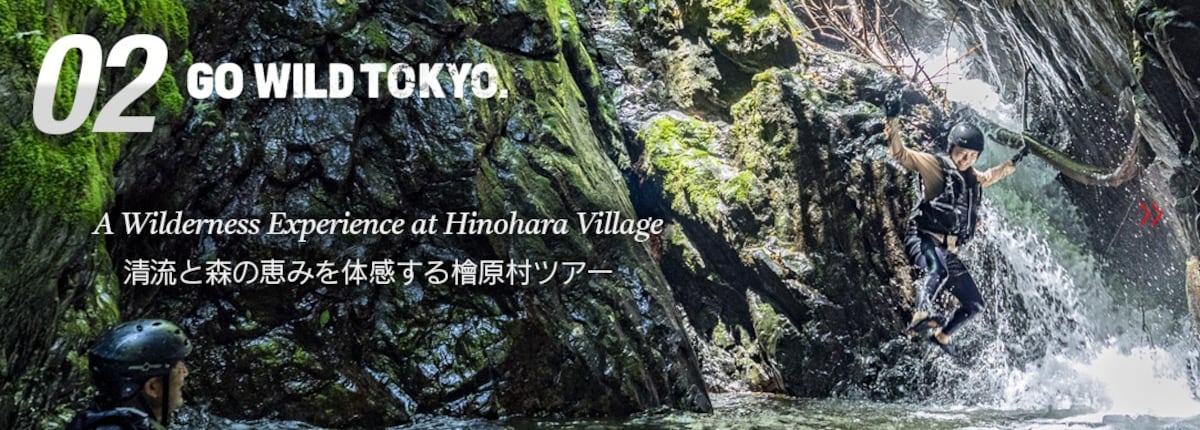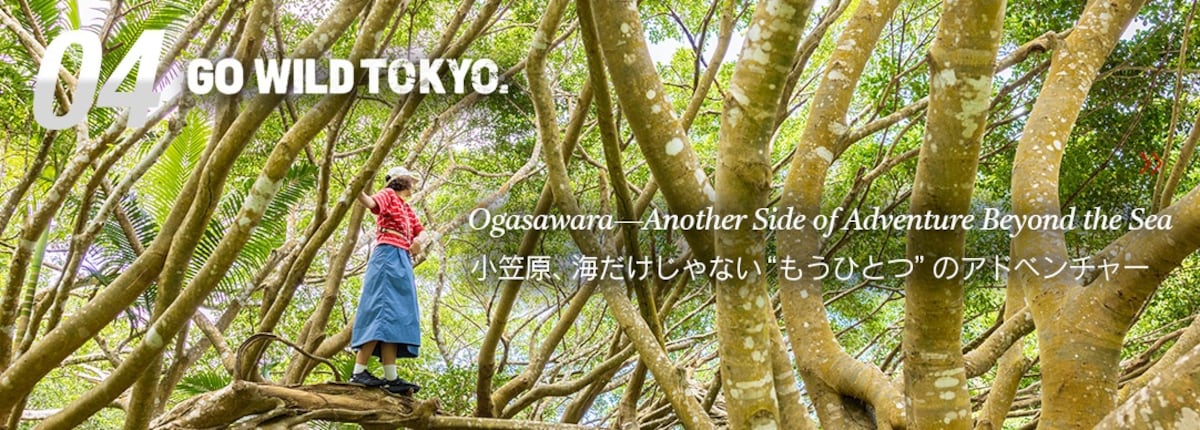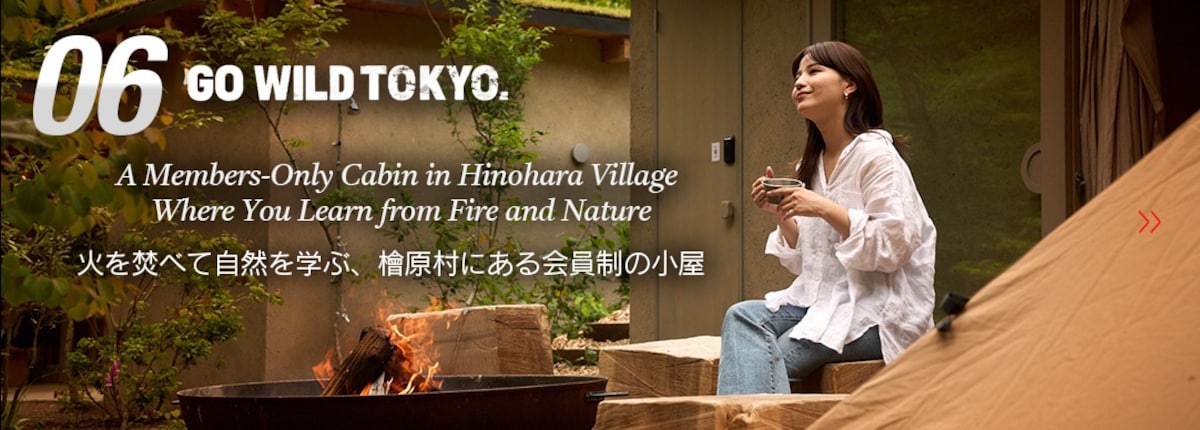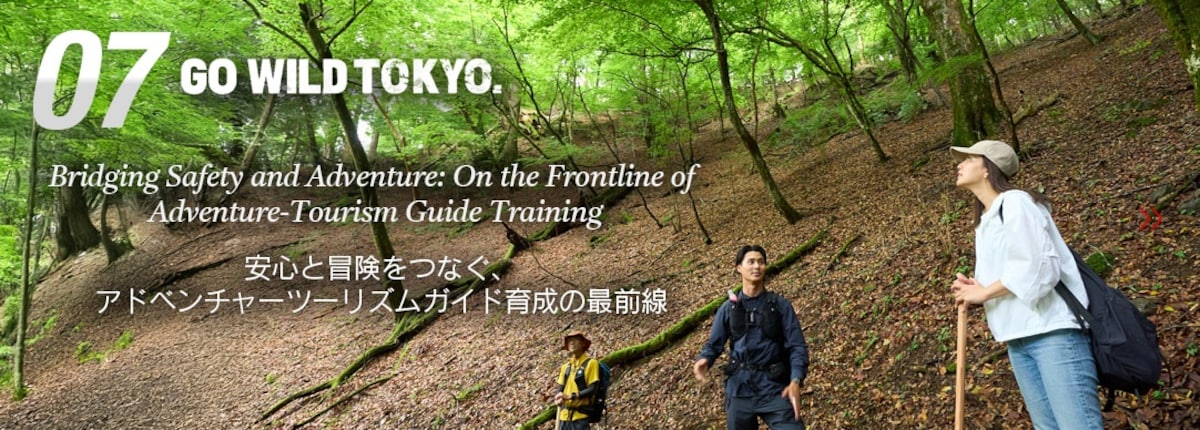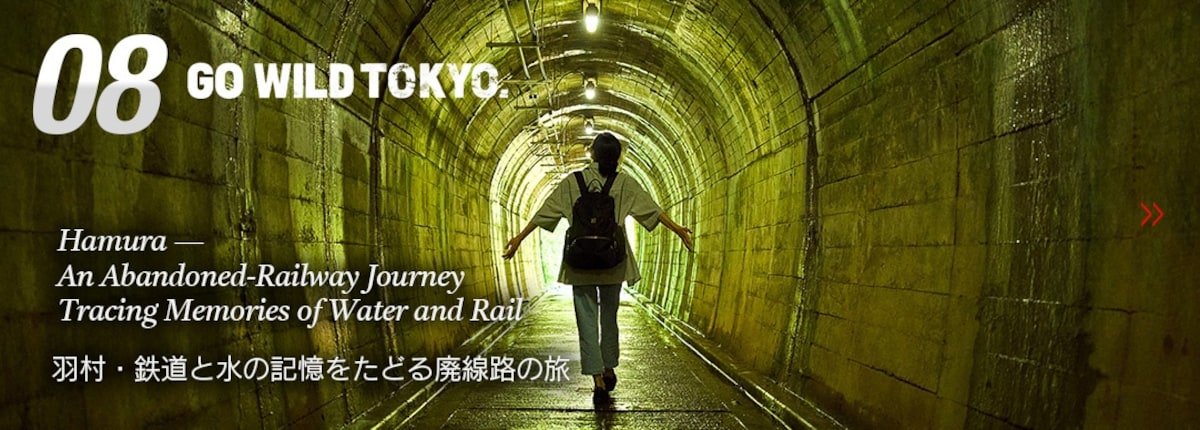GO WILD TOKYO 1/ Experience the great outdoors on Izu Oshima Island

Tokyo is one of Japan’s 47 prefectures, and its borders stretch far beyond the skyline and bustling streets. This article is the first of a series called “GO WILD TOKYO,” featuring trips that let you experience Tokyo’s great outdoors. In this we introduce parts of Tokyo known for natural wonders, landscapes, and wildlife.
By AAJ Editorial TeamIzu Oshima Island is a dynamic natural location offering adventure tourism activities within Tokyo’s borders. It is characterized by its volcanic make-up, its natural landscape, and its famous camellias. The island is easily accessible, making it perfect for relaxed trip featuring varied outdoor activities. Located 120 kilometers south of central Tokyo, it can be reached in as little as 1 hour and 45 minutes by high-speed jet ferry from Takeshiba Passenger Terminal or just 25 minutes by air from Chofu Airport.
Gojinka Cycle is a local business that rents stylish, electric-assist bicycles that are a comfortable way to tour the island while experiencing its rich history and natural beauty. Kristina, an influencer who came to Japan in 2016 and is currently sharing the charms of Japan with the world through her social media, enjoyed an adventure tourism experience on Izu Oshima using this electric-assist bicycle.
An Island Paradise Where Visitors Can Experience Tokyo's Great Outdoors
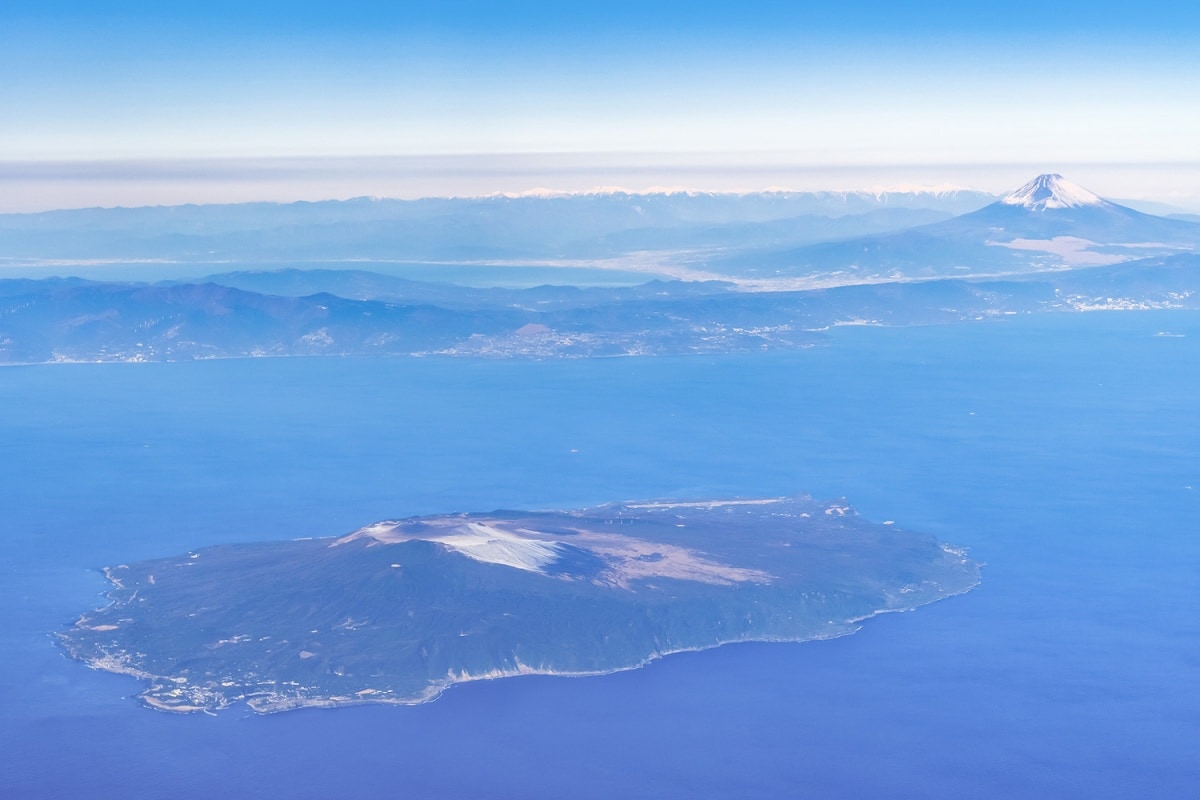
Kristina’s first stop after arriving in Izu Oshima is at Gojinka Cycle, where she meets owner Iwao Takagi. The shop is located in Motomachi, the town at the foot of Mt. Mihara, the active volcano that towers over the island. Takagi describes the island and the activities visitors can look forward to. “The charm of Izu Oshima lies in its sea and mountains,” he says. “Mt. Mihara is an active volcano, and you can feel the breath of the earth, with smoke rising from the mountain. The adventures begin as soon as you set foot on the island, as you can enjoy activities like mountain trekking, cycling around the island, and marine sports. With an electric-assist bicycle, you can comfortably tour the island while feeling the breeze and fully immerse yourself in adventure tourism. Even though we’re just two hours from central Tokyo, the atmosphere is completely different. Summers here are cooler than in the urban area, and winters are warmer.”
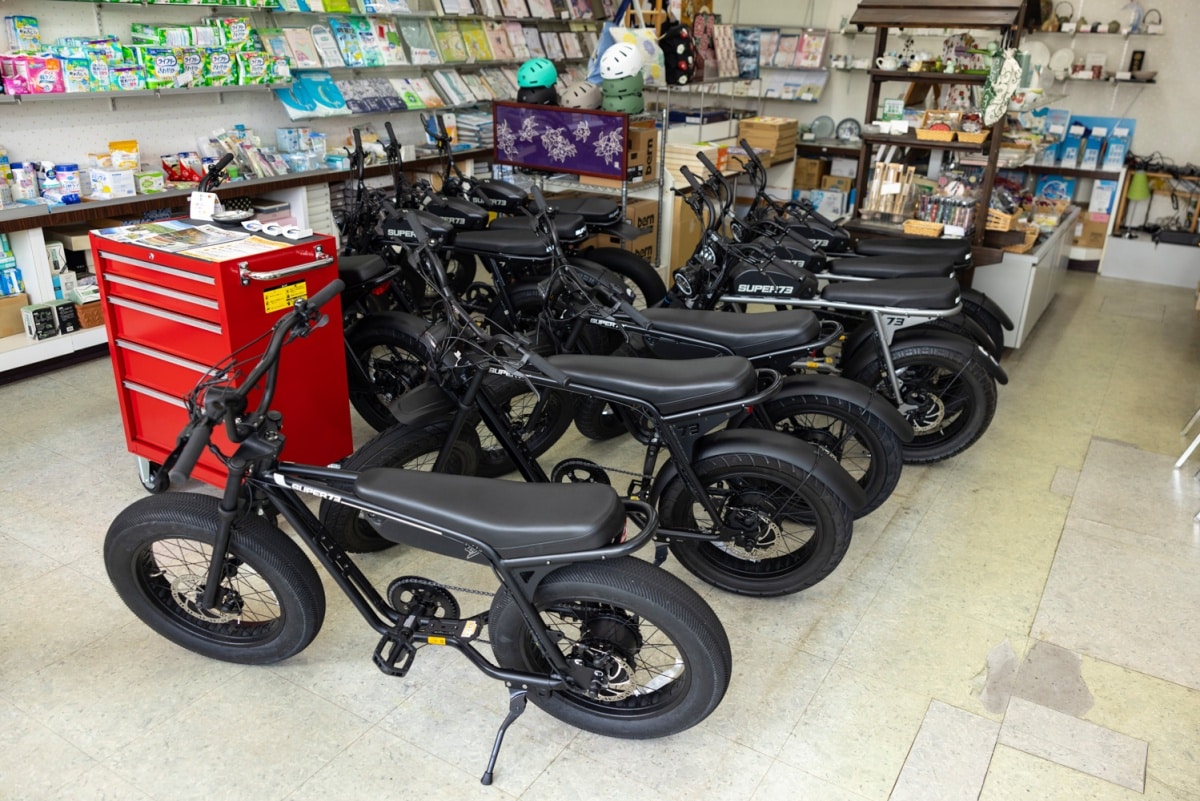
The SUPER 73 electric-assist bicycles on display at Gojinka Cycle in Motomachi. Originating from Southern California, these bikes offer the ease of cycling combined with the unique feel of riding a motorcycle.

Motomachi Port is one of the main gateways for boat trips to Izu Oshima. It also functions as an access point to the Sunset Palm Line along the coast.
Experience the Island on Electric-assist Bicycles

Gojinka Cycle’s Takagi recommends the electric assist bicycles for getting around. They are powerful, with sturdy frames and thick tires that offer excellent stability, making them reliable for both off-road trails and bumpy city streets.
A place you definitely should visit is Ura Sabaku, a black desert formed by the accumulation of fine lava and volcanic ash from Mt. Mihara's eruptions. It is located east of the Oshima Circuit Road (approximately 43 km long). There are various routes to access Ura Sabaku. However, some areas prohibit entry by bicycle or car, so it's necessary to check local restrictions.
Kristina seeks to learn more from Takagi about recommended routes she can go by bicycle. Takagi suggests the Sunset Palm Line, which begins in Motomachi and takes less than an hour for a round trip. It's a single road along the coast that locals cherish and enjoy for walks and runs. On clear days, even Mt. Fuji is visible, adding to the scenic beauty of the route. Another route runs from the Sunset Palm Line and covers the northern half of Oshima in about half a day. Takagi says, “You can visit Ura Sabaku of Mount Mihara, see the 800-year-old cherry blossom tree, climb up from Hydrangea Rainbow Line to the Gojinka Chaya tea house on Mt. Mihara, and finally enjoy a downhill ride back to Motomachi. There are some ups and downs, but with an electric-assist bike, you can feel confident of covering the route even if you're concerned about your fitness level.”
“The Izu Peninsula and Mt. Fuji can be seen on the horizon beyond the sea,” says Kristina. “They feel so close, it seems that you could almost reach out and touch them! Riding a bike gives you the freedom to move around and feel the wind, which is amazing. It's not every day you get to cycle through a desert, so this experience was truly special. If you love outdoor activities, you're definitely going to enjoy this!”

The wild white Oshima cherry blossoms. Located along the Hydrangea Rainbow Line, it's a must-stop spot during your cycling journey.
For serious cyclists, the most popular route is undoubtedly the full-day island circuit (approximately 43 km along Oshima Circuit Road). Starting from Motomachi, it reaches sites such as Ura Sabaku, Fudeshima (a brush-shaped rock), Habu Port, and the Great Road Cut (a large exposed pyroclastic wall).
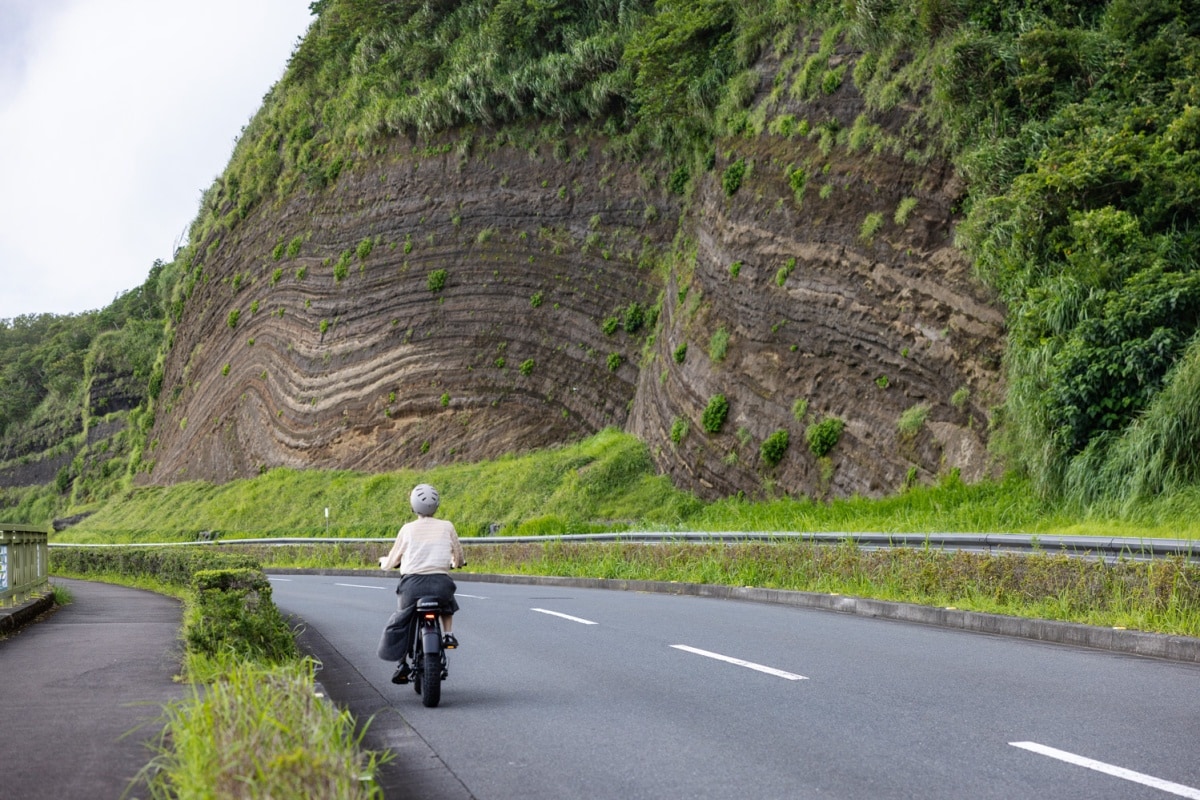
The Geological Strata Cut, located roughly midway between Motomachi and Habu Port, features distinctive striped patterns formed by deposits from about 100 volcanic eruptions.

A hill called Akappage, marked by its red color from past volcanic eruptions, can be found halfway along the Sunset Palm Line at the northern tip of the island.
Touring the history and culture of Izu Oshima by bicycle
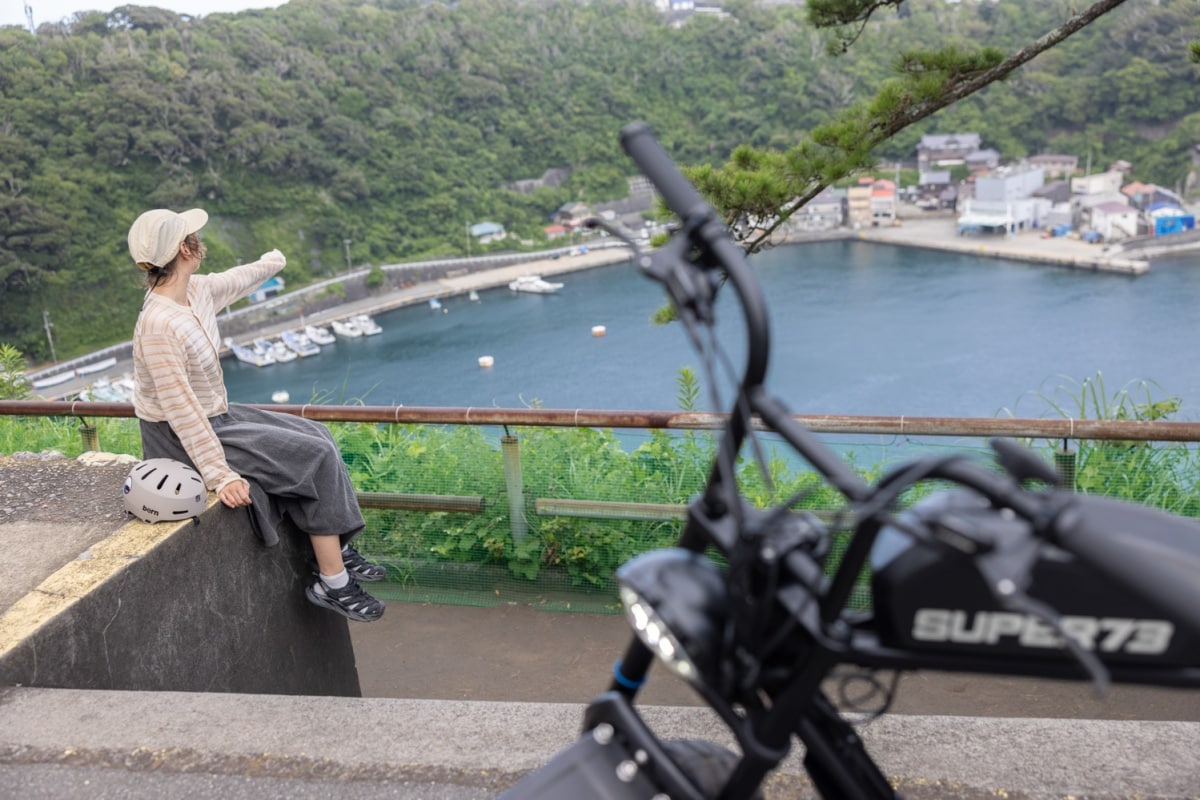
A view of picturesque Habu Port from the Oshima Circuit Road in the southern part of Oshima.
An hour's ride south from Gojinka Chaya along the Oshima Circuit Road takes you to the renowned Habu Port, a destination rich in history and charm . This Port, in the southern part of the island, was originally a crater lake formed by a ninth-century volcanic eruption. The crater wall collapsed, connecting it to the sea, after the 1703 Genroku earthquake's tsunami.
The port is about an hour's bike ride from Motomachi. Around 100 years ago, this area was a popular destination for many cultural figures, and it remains one of the island’s favorite walking courses. Along the “Literary Walking Path,” you can enjoy the island's scenery and atmosphere, with panels and monuments introducing works by writers and poets associated with Izu Oshima.
“The Literary Walking Path is so charming, and it's full of photo-worthy spots that make you want to capture every moment,” says Kristina. “I knew about the book, “The Dancing Girl of Izu,” but realizing this was the setting makes it an irresistible place for fans of Japanese literature. The romantic scenery really brings the story to life, and with a bike, you can take your time and explore at your own pace, fully enjoying the atmosphere.”
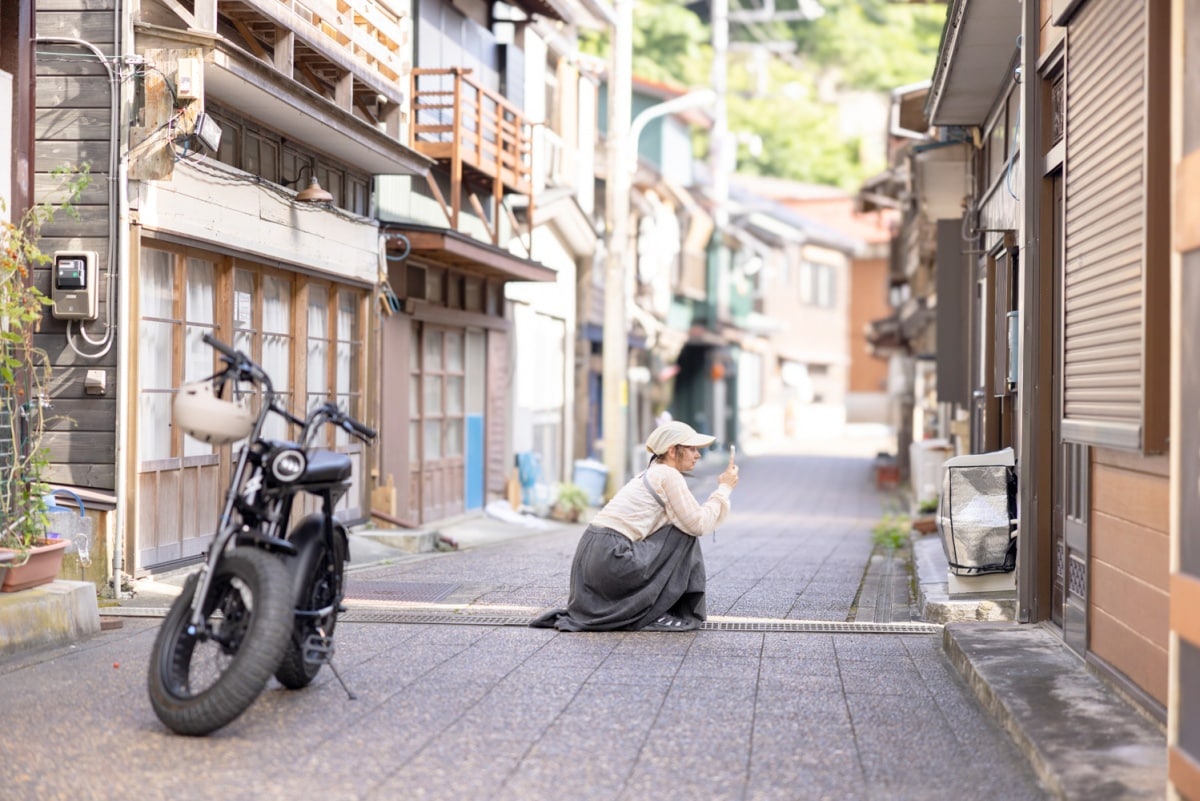
Habu Port’s streets are lined with traditional houses, some repurposed into restaurants and shops.
Nature isn't the only thing this island offers. One of the true delights of adventure tourism is taking advantage of your bicycle to immerse yourself in the island's history and culture. Kristina’s bike ride concludes in Habu Port, about an hour's bike ride from Motomachi on the south of the island. The port was originally a volcanic crater. Later, a tsunami broke down the crater wall, connecting it to the sea and forming a caldera. The area was popular with many cultural figures about 100 years ago. The streetscape of Habu Port, lined with old wooden buildings, has long been a draw for many tourists. Restaurants and lodgings have been renovated from traditional houses, preserving their historic charm.

When it comes to Izu Oshima's specialties, Ashitaba (Angelica) and island seaweed come to mind. Freshly fried tempura and rice balls made with them are hidden culinary gems!
Other famous products of Oshima are Ashitaba and island seaweed, which have been consumed since the Edo period (1603–1868) . A particularly important place in the island’s history is held by the camellia, which is said to have already existed as far back as around 1,200 years ago.
Izu Oshima's warm, rainy climate and well-draining volcanic soil have made it an ideal environment for indigenous camellias. As a result, the people of Izu Oshima have continued to plant these trees as windbreaks and for charcoal and oil production. It's said that there may be as many as 3 million camellia trees on the island.
At the Tsubaki (Camellia) Corporation factory in Motomachi, Kristina is greeted by factory manager Genki Fukui.
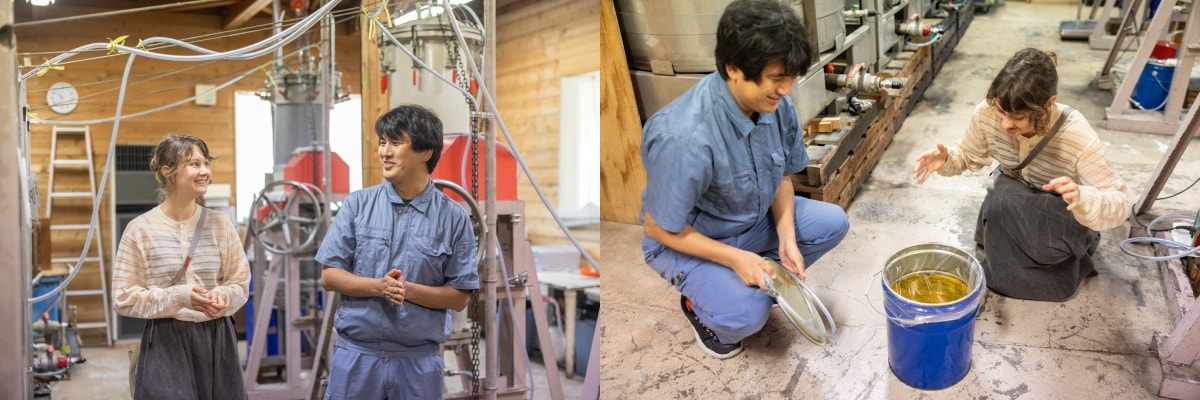
Visitors can actually see the camellia oil refining process in action.
The company is working on developing new ways to use camellia oil, such as in facial care cosmetics and as an edible oil for salads. “Camellia oil is rich in oleic acid, which can help reduce blood cholesterol and prevent lifestyle-related diseases,” says Fukui. “That's why it's gaining attention from many health-conscious individuals.”
During the factory tour, visitors can observe the process of pressing and refining camellia seeds. The company takes pride in its high-quality camellia oil, which is produced using a unique method that doesn't apply heat during pressing and uses only filtration for refining. Additionally, visitors can hear about the history of camellias on Izu Oshima and how the local residents have been involved with them over the years. “I always thought camellia oil was mainly for beauty purposes, like applying it to hair,” says Kristina. “I had no idea it could be used for cooking. I'd love to try it, maybe drizzled over gelato made with Oshima milk.”
Gojinka Cycle: Exploring Mt. Mihara's New Charms
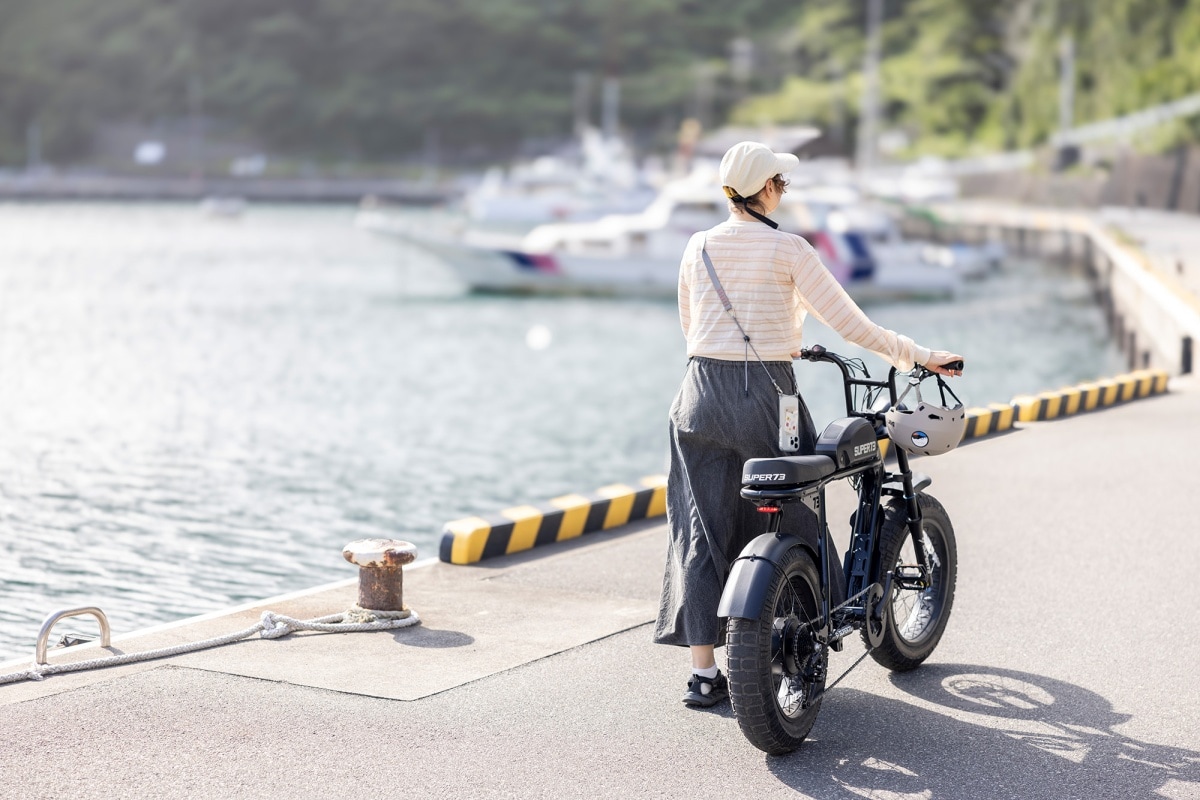

Iwao Takagi of Gojinka Cycle and Gojinka Chaya.
Iwao Takagi is not only the owner of the bicycle shop, but the fifth-generation owner of Gojinka Chaya, a tea house near the summit of Mt. Mihara. He took over two years ago, when there was talk of closing the shop due to the impact of the COVID-19 pandemic.
According to Takagi, Izu Oshima has been certified as a Japan Geopark, which is part of a UNESCO-supported initiative for places where you can learn about the relationship between the Earth and life. “In the future,” he says, “We'd like to collaborate with certified Geo-guides to offer programs where people can enjoy cycling while learning about the island's geology and topography in a fun way.”
“On Izu Oshima, we've long revered the rising magma and red-tinged sky, calling it gojinka (divine fire),” he says. “The teahouse was named by its first owner, Kyutaro Takagi, a pioneer who developed the hiking trail up Mt. Mihara. I couldn't let Gojinka Chaya, with its long history, close during my generation. I also named our bicycle rental business after Gojinka because I wanted visitors to know that respect for nature is still alive on this island.”

Gojinka Cycle
Address: inside Harika Oshima, Motomachi 2 Chome 17-8, Oshima Town, Tokyo [MAP]
Phone: 04992-2-3351
Hours: 9:30 AM - 6:00 PM (Monday through Sunday)
Website:https://gojinkacycle.com/
SNS:https://www.instagram.com/gojinka_cycle/
Main Access Routes from Honshu to Oshima:
• By Sea: Tokyo Takeshiba Passenger Ship Terminal to Oshima (2-3 trips per day / Tokai Kisen), 1 hour 45 minutes by high-speed ferry.
• By Air: Chofu Airport to Oshima Airport (3 flights per day / New Central Airservice), 25 minutes.
Access to Gojinka Cycle from Oshima:
• By Car: 17 minutes (approx. 7.7 km) from Okada Port, 2 minutes (approx. 650 m) from Motomachi Port, and 9 minutes (approx. 4.5 km) from Oshima Airport.

[Adventure Tourist]
Kristina Minami
Travel content creator with extensive experience in producing Japan-related content. She introduces lesser-known tourist destinations, offering new perspectives to her international and domestic followers. Currently, she's not just a travel influencer but also a tourism industry professional, working on PR projects, serving as a tourism advisor, and acting as a travel planner. Her monthly reach on social media exceeds 4 million people.([Instagram]
※This content is supported by a grant from the Tokyo Convention & Visitors Bureau for the Promotion of Adventure Travel.
Text by Toru Otawara; Photos by Atsushi Ishihara


